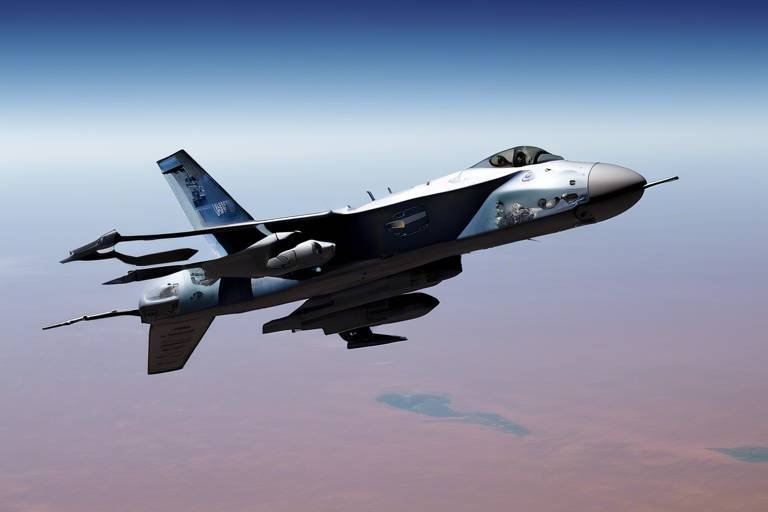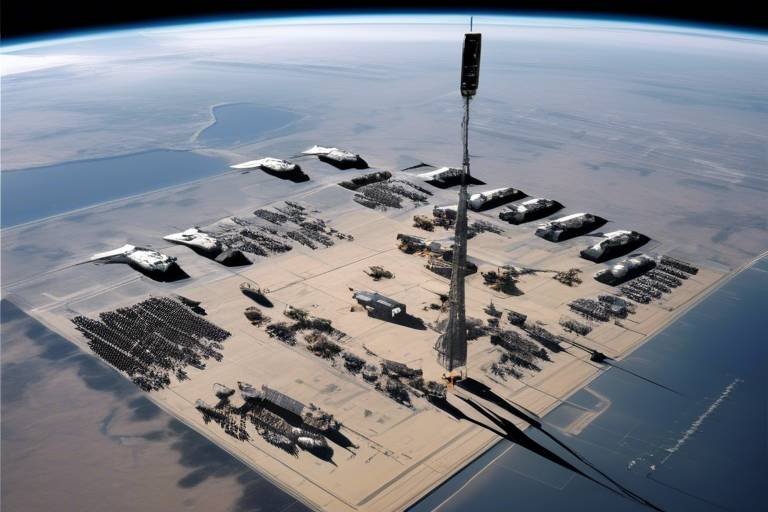The Importance of Secure Satellite Communication in Defense
In today’s fast-paced world, where every second counts and the stakes are incredibly high, secure satellite communication stands as a cornerstone of defense operations. Imagine a battlefield where decisions must be made in the blink of an eye, where the safety of troops and the success of missions hinge on the ability to communicate effectively and securely. This is the reality for military forces around the globe. The significance of secure satellite communication cannot be overstated; it is not just about transmitting data, but about ensuring that this data remains confidential, intact, and accessible only to those who need it. As we delve deeper into this topic, we will explore how satellite communication has revolutionized modern warfare, the challenges it faces, and the technological advancements that are shaping its future.
At its core, secure satellite communication enhances national security by providing real-time information that is vital for strategic planning and execution. When military leaders can communicate instantly with their units, they can make informed decisions that can turn the tide of battle. This immediacy is crucial, especially in scenarios where every moment counts. Furthermore, the operational efficiency that comes from this communication allows for better resource management and coordination among different branches of the military, leading to more effective operations. In essence, secure satellite communication is not merely a tool; it is a lifeline that connects various elements of military strategy and execution.
However, the importance of secure satellite communication goes beyond mere operational efficiency. It is also about technological advancements that have paved the way for more secure and reliable communication channels. With the advent of next-generation satellites equipped with state-of-the-art features, military forces can now rely on enhanced security protocols that protect sensitive information from prying eyes. This technological evolution is essential, as it ensures that military operations can proceed without the constant fear of interception or sabotage.
As we move forward, it is imperative to recognize that the landscape of threats is constantly evolving. The challenges faced by secure satellite communication, from cybersecurity threats to signal jamming, require ongoing innovation and adaptation. The military must remain vigilant and proactive in addressing these challenges, ensuring that secure satellite communication continues to serve as a robust foundation for defense operations. In the following sections, we will examine these challenges in detail and discuss the innovative solutions being developed to overcome them.
- Why is secure satellite communication crucial for national defense?
Secure satellite communication is essential for ensuring that military operations can be conducted efficiently and securely, protecting sensitive information from adversaries. - What are the main challenges to secure satellite communication?
Challenges include cybersecurity threats, signal jamming, and vulnerabilities in satellite infrastructure. - How can military forces mitigate cybersecurity threats?
By implementing advanced encryption, conducting regular security audits, and utilizing real-time monitoring systems. - What innovations are shaping the future of satellite communication?
Technological advancements such as next-generation satellites and encryption technologies are enhancing the security and efficiency of military communications.
The Role of Satellite Communication in Modern Warfare
In the ever-evolving landscape of modern warfare, satellite communication stands as a pivotal element that has revolutionized the way military operations are conducted. Imagine a battlefield where information flows seamlessly across vast distances, allowing commanders to make informed decisions in real-time. This is the power that satellite communication brings to the table. It enables troops to stay connected, share vital intelligence, and coordinate actions, all while operating in diverse and often hostile environments.
One of the most significant advantages of satellite communication is its ability to provide real-time data. In military operations, timing is everything. The faster a commander can receive and process information, the quicker they can respond to threats. This immediacy can mean the difference between success and failure in critical missions. For instance, during a combat operation, satellite communication allows for the rapid transmission of reconnaissance data, enabling ground forces to adapt their strategies on the fly.
Moreover, satellite communication enhances strategic decision-making. With access to comprehensive data, military leaders can analyze the battlefield from a macro perspective, identifying trends and potential threats that may not be visible from the ground. This level of situational awareness is crucial for planning and executing complex operations, especially in joint missions involving multiple branches of the military or allied forces.
Another key aspect of satellite communication is its role in ensuring operational efficiency. By providing a reliable communication link, military units can maintain constant contact, reducing the risk of miscommunication and enhancing coordination. This is particularly important in joint operations where various units must work together seamlessly. The ability to communicate effectively across different platforms—land, air, and sea—ensures that all forces are on the same page, ultimately leading to more successful outcomes.
However, the advantages of satellite communication extend beyond just tactical benefits. It also plays a crucial role in logistics and support operations. For instance, supply chain management in military operations relies heavily on accurate and timely communication. Satellite systems allow for the tracking of supplies and equipment, ensuring that troops receive the resources they need when they need them. This logistical support is vital for maintaining troop morale and operational readiness.
To further illustrate the impact of satellite communication in modern warfare, consider the following table that summarizes its key roles:
| Key Role | Description |
|---|---|
| Real-Time Data Transmission | Immediate access to critical information for timely decision-making. |
| Strategic Decision-Making | Enhanced situational awareness for effective planning and execution. |
| Operational Efficiency | Improved coordination and reduced risk of miscommunication. |
| Logistics and Support | Effective tracking and management of supplies and resources. |
In conclusion, the role of satellite communication in modern warfare cannot be overstated. It is a force multiplier that enhances the capabilities of military forces across the globe. As technology continues to advance, the reliance on secure and efficient satellite communication will only grow, shaping the future of military operations in profound ways.
Challenges to Secure Satellite Communication
In the realm of modern defense, the significance of secure satellite communication cannot be overstated. However, it is essential to recognize that this critical infrastructure is not without its challenges. As military operations increasingly rely on satellite systems for real-time intelligence and coordination, a host of vulnerabilities and threats have emerged that could undermine the integrity and effectiveness of these communications. From cybersecurity threats to signal jamming, the landscape of secure satellite communication is fraught with potential pitfalls that must be navigated with care.
One of the most pressing issues facing secure satellite communication today is the rise of cybersecurity threats. With the rapid advancement of technology, adversaries have become more sophisticated in their attempts to infiltrate military networks. Cyberattacks can take various forms, such as hacking, phishing, and the deployment of malware, all aimed at compromising sensitive information. The consequences of such breaches can be catastrophic, potentially leading to the exposure of classified data or even the disruption of critical operations. This reality underscores the necessity for robust cybersecurity measures that can defend against these evolving threats.
Cybersecurity threats are not merely a theoretical concern; they represent a tangible danger that military organizations must actively combat. The interconnected nature of satellite communication systems means that a breach in one area can have cascading effects throughout the entire network. For instance, if an adversary successfully gains access to a satellite's control system, they could manipulate its operations or intercept communications, leading to severe operational setbacks.
To illustrate the variety of cyber threats that can target satellite networks, consider the following:
- Hacking: Unauthorized access to satellite systems can allow adversaries to manipulate data or disrupt services.
- Malware: Malicious software can be introduced to compromise the integrity of communications and steal sensitive information.
- Phishing: Deceptive emails or messages can trick personnel into revealing login credentials or other sensitive data.
These threats emphasize the urgency for comprehensive security protocols to safeguard communication integrity. Military organizations must adopt a proactive approach, continuously updating their defenses against the ever-evolving landscape of cyber threats.
To combat these cyber threats effectively, several mitigation strategies can be implemented. For instance, employing advanced encryption techniques ensures that even if data is intercepted, it remains unreadable to unauthorized parties. Regular security audits can help identify vulnerabilities within the satellite communication systems, allowing for timely interventions before a breach occurs. Furthermore, real-time monitoring of network activity can provide early warnings of potential threats, enabling rapid response to mitigate damage.
Another significant challenge to secure satellite communication is signal jamming and interference. In military operations, the ability to maintain uninterrupted communication is crucial, especially during critical missions where every second counts. Unfortunately, adversaries can employ jamming techniques to disrupt signals, rendering communication ineffective. This not only hampers operational efficiency but can also put personnel at risk.
To address these challenges, military organizations must invest in developing countermeasures that ensure robust communication channels. This includes implementing technologies that can detect and counteract jamming attempts, thereby maintaining the integrity of satellite communications even in hostile environments. As the stakes continue to rise, the need for secure satellite communication that can withstand these challenges has never been more urgent.
Q1: What are the main threats to secure satellite communication?
A1: The main threats include cybersecurity attacks such as hacking and malware, as well as physical threats like signal jamming and interference.
Q2: How can military organizations protect their satellite communication systems?
A2: They can implement advanced encryption, conduct regular security audits, and utilize real-time monitoring to detect and respond to potential threats.
Q3: Why is secure satellite communication critical for defense operations?
A3: It enables real-time data sharing, strategic decision-making, and coordination among military forces, which are vital for successful operations.
Cybersecurity Threats
In today's digital age, have emerged as one of the most significant challenges facing secure satellite communication systems. As military operations increasingly rely on these technologies for critical data transmission, the potential for malicious attacks has grown exponentially. Imagine a scenario where enemy hackers infiltrate satellite networks, intercepting sensitive information that could jeopardize national security. This is not just a hypothetical situation; it is a reality that defense organizations must confront.
There are various types of cyber threats that can target satellite communication networks, each posing unique risks. Some of the most concerning threats include:
- Hacking: Unauthorized access to satellite systems can lead to data breaches and manipulation of information.
- Malware: Malicious software can disrupt operations, corrupt data, or even take control of satellite functions.
- Phishing Attacks: Deceptive tactics aimed at personnel can result in the compromise of login credentials and other sensitive information.
To counter these threats, it is essential to implement robust security protocols. Regular security audits and real-time monitoring are critical components of a comprehensive defense strategy. Just as a fortress requires strong walls and vigilant guards, satellite communication systems need advanced encryption and ongoing vigilance to protect against cyber intrusions.
Moreover, the stakes are high. A successful cyberattack could not only disrupt military operations but also lead to catastrophic consequences on a global scale. Therefore, investing in cutting-edge cybersecurity measures is not just a precaution; it is a necessity for ensuring the integrity and confidentiality of military communications.
In summary, as threats evolve, so must the strategies to combat them. The focus should be on creating a resilient infrastructure that can withstand the ever-changing landscape of cyber threats, ensuring that vital communication channels remain secure and operational in the face of adversity.
Types of Cyber Threats
In the realm of secure satellite communication, understanding the various is crucial for safeguarding military operations. As technology evolves, so too do the tactics employed by adversaries aiming to exploit vulnerabilities. Cyber threats can manifest in several forms, each posing unique risks to satellite networks and the sensitive data they transmit.
One of the most prevalent threats is hacking. Cybercriminals often target satellite communication systems to gain unauthorized access, potentially compromising sensitive military information. This could lead to the theft of classified data or even manipulation of communication channels, which can have dire consequences during critical missions.
Another significant threat comes from malware. This malicious software can infiltrate satellite systems, disrupting operations or providing a backdoor for further attacks. Malware can be introduced through various means, including phishing attacks or unsecured devices connected to the network. Once inside, it can wreak havoc, making it essential for military organizations to employ stringent security measures.
Moreover, Denial of Service (DoS) attacks can overwhelm satellite communication systems, rendering them inoperable. By flooding the system with excessive requests, attackers can disrupt communication channels, leading to a loss of critical connectivity during operations. This type of threat emphasizes the necessity for robust infrastructure capable of handling unexpected surges in traffic.
To further illustrate the landscape of cyber threats, consider the following table summarizing the key types:
| Type of Cyber Threat | Description |
|---|---|
| Hacking | Unauthorized access to satellite systems to steal or manipulate data. |
| Malware | Malicious software that disrupts operations or creates backdoors for attacks. |
| Denial of Service (DoS) | Overloading systems with traffic to disrupt communication. |
In addition to these threats, social engineering tactics can also be employed by adversaries to manipulate personnel into divulging sensitive information. This highlights the importance of not only technological defenses but also comprehensive training for personnel involved in satellite operations. By fostering a culture of security awareness, military organizations can significantly reduce the risk of falling victim to such deceptive tactics.
In conclusion, the landscape of cyber threats targeting satellite communication is complex and ever-evolving. By understanding these threats—hacking, malware, DoS attacks, and social engineering—military organizations can better prepare themselves to implement effective countermeasures, ensuring the integrity and security of their operations.
- What are the most common cyber threats to satellite communication? The most common threats include hacking, malware, and Denial of Service attacks.
- How can military organizations protect against these threats? Implementing robust security protocols, regular training, and advanced monitoring systems are essential for protection.
- What role does personnel training play in cybersecurity? Training helps personnel recognize and respond to potential threats, reducing the risk of successful attacks.
Mitigation Strategies
In the realm of secure satellite communication, are essential to counteract the ever-present risks posed by cybersecurity threats. As military operations increasingly rely on satellite networks for critical communication, it becomes imperative to implement robust measures that not only protect sensitive data but also ensure the integrity and availability of these communication systems. One of the primary strategies involves the use of advanced encryption technologies. By encrypting data at both the transmission and storage levels, military organizations can safeguard their communications against unauthorized access and potential cyberattacks.
Moreover, conducting regular security audits is another crucial strategy. These audits help identify vulnerabilities within the satellite communication infrastructure and assess the effectiveness of existing security protocols. By routinely evaluating their systems, defense organizations can stay one step ahead of potential threats, making necessary adjustments to fortify their defenses.
Real-time monitoring plays a pivotal role in enhancing the resilience of satellite communication systems. By employing sophisticated monitoring tools, military personnel can detect unusual activities or anomalies in communication patterns that may indicate a cyber intrusion. This proactive approach allows for swift responses to potential threats, minimizing the impact of any security breaches.
Furthermore, it's essential to foster a culture of cybersecurity awareness among all personnel involved in satellite operations. Training and education programs can empower military staff to recognize phishing attempts, social engineering tactics, and other common cyber threats. By equipping personnel with the knowledge to identify and respond to these threats, organizations can significantly reduce the risk of successful cyberattacks.
In addition to these strategies, collaboration with industry experts and cybersecurity firms can provide valuable insights into emerging threats and best practices for defense. By sharing knowledge and resources, military organizations can strengthen their overall security posture and enhance their ability to operate securely in a complex and evolving landscape.
In conclusion, the implementation of these mitigation strategies is not just a precaution; it is a necessity in the face of growing cybersecurity threats. By prioritizing encryption, conducting regular audits, monitoring systems in real-time, and fostering a culture of awareness, military organizations can better protect their satellite communication systems and ensure the success of their operations.
- What is the primary purpose of secure satellite communication in defense?
The primary purpose is to ensure reliable and secure communication for military operations, allowing for real-time decision-making and coordination. - How can encryption enhance satellite communication security?
Encryption protects sensitive data by converting it into a format that can only be read by authorized personnel, thus preventing unauthorized access. - What are the consequences of signal jamming on military operations?
Signal jamming can disrupt communication, leading to miscommunication and potential operational failures, which can compromise mission success. - Why is cybersecurity awareness important for military personnel?
Cybersecurity awareness helps personnel recognize and respond to threats, reducing the risk of cyberattacks that could jeopardize sensitive information.
Signal Jamming and Interference
In the realm of modern defense, signal jamming and interference represent significant threats that can severely disrupt military operations. Imagine a battlefield where communication is vital for coordination among troops, and suddenly, the lines of communication go dead. This scenario is not just a plot from a military thriller; it's a real risk that defense forces face today. Signal jamming occurs when an adversary uses technology to block or interfere with the signals transmitted between satellites and ground stations. This can lead to a breakdown in the flow of critical information, which can be disastrous during critical operations.
Moreover, the potential for interference is not limited to intentional jamming. Environmental factors, such as severe weather conditions or geographical obstacles, can also cause disruptions. For example, heavy rain or dense foliage can weaken signals, making it challenging for military personnel to maintain effective communication. Therefore, the need for robust countermeasures against both deliberate jamming and unintentional interference is paramount.
To combat these challenges, military organizations are investing in advanced technologies that enhance the resilience of their satellite communication systems. Here are some key strategies being employed:
- Adaptive Signal Processing: This technology allows systems to adjust to changing signal conditions dynamically, ensuring that communication remains stable even in adverse environments.
- Frequency Hopping: By rapidly switching frequencies during transmission, military communications can evade detection and jamming attempts, making it harder for adversaries to disrupt signals.
- Redundant Systems: Implementing backup communication channels ensures that if one system is compromised, another can take over immediately, maintaining operational integrity.
In conclusion, as military operations become increasingly reliant on satellite communication, the threats posed by signal jamming and interference cannot be underestimated. By investing in innovative technologies and developing comprehensive strategies, defense forces can enhance their communication capabilities and ensure that they remain connected, even in the face of adversity. The ongoing evolution of communication technology will play a critical role in maintaining operational effectiveness in a world where every second counts.
Q1: What is signal jamming in satellite communication?
A1: Signal jamming occurs when an adversary uses technology to block or interfere with the signals transmitted between satellites and ground stations, disrupting communication channels.
Q2: How does weather affect satellite communication?
A2: Severe weather conditions, such as heavy rain or storms, can weaken satellite signals, leading to potential communication breakdowns during critical operations.
Q3: What technologies are used to counter signal jamming?
A3: Technologies like adaptive signal processing, frequency hopping, and redundant systems are employed to enhance the resilience of satellite communication against jamming and interference.
Technological Innovations in Satellite Communication
This article explores the critical role of secure satellite communication in defense operations, highlighting its significance for national security, operational efficiency, and technological advancements in military communications.
Satellite communication has transformed modern warfare by providing real-time data and connectivity, enabling strategic decision-making and coordination among military forces in diverse operational environments.
Despite its advantages, secure satellite communication faces numerous challenges, including cybersecurity threats, signal jamming, and vulnerabilities in satellite infrastructure that can compromise defense operations.
Cybersecurity threats pose significant risks to satellite communication systems, necessitating robust measures to protect sensitive military information from potential cyberattacks by adversaries.
Various types of cyber threats, including hacking and malware, can target satellite networks, emphasizing the need for comprehensive security protocols to safeguard communication integrity.
Implementing advanced encryption, regular security audits, and real-time monitoring can help mitigate cybersecurity threats and enhance the resilience of satellite communication systems.
Signal jamming and interference can disrupt satellite communication, highlighting the importance of developing countermeasures to ensure uninterrupted communication during critical defense operations.
Advancements in technology are continuously improving satellite communication capabilities, offering enhanced security features and increased bandwidth for military applications. These innovations are not just about keeping pace with technological evolution; they are about staying one step ahead of potential adversaries. For example, the integration of artificial intelligence (AI) into satellite systems allows for predictive maintenance and real-time analysis of communication channels, significantly improving operational efficiency.
Moreover, the development of quantum communication is an exciting frontier that promises unbreakable encryption methods. This technology utilizes the principles of quantum mechanics to secure data transmission, making it virtually impossible for unauthorized entities to intercept communications. As we look at the landscape of satellite technology, it’s clear that these innovations are not merely enhancements; they are essential for ensuring the integrity and security of military communications.
Another significant innovation is the emergence of next-generation satellites. These satellites are equipped with advanced features that enhance secure communication, including improved signal processing and anti-jamming capabilities. With these enhancements, military forces can maintain reliable communication even in contested environments. The following table outlines some key features of next-generation satellites:
| Feature | Description |
|---|---|
| Advanced Signal Processing | Enhances the clarity and reliability of communications, reducing noise and interference. |
| Anti-Jamming Capabilities | Prevents disruption from signal jamming, ensuring continuous communication during operations. |
| Increased Bandwidth | Allows for the transmission of larger data packets, essential for real-time intelligence sharing. |
| Enhanced Security Features | Incorporates state-of-the-art encryption methods to protect sensitive information. |
In conclusion, the future of secure satellite communication looks promising with these technological innovations. As military operations become more complex, the demand for secure, reliable, and efficient communication systems will only grow. Embracing these advancements is not just beneficial; it is crucial for maintaining national security and operational effectiveness in the face of emerging threats.
- What is secure satellite communication? Secure satellite communication refers to the use of satellite technology to transmit information in a way that protects it from unauthorized access and interference.
- How does encryption enhance satellite communication security? Encryption transforms data into a coded format that can only be read by authorized users, making it difficult for adversaries to intercept and understand the information.
- What are next-generation satellites? Next-generation satellites are advanced satellite systems equipped with cutting-edge technologies that enhance communication capabilities and security features.
- Why is cybersecurity important for satellite communication? Cybersecurity is vital for satellite communication as it protects sensitive military information from cyberattacks that can compromise operational integrity.
Encryption Technologies
In the realm of secure satellite communication, encryption technologies stand as the frontline defense against unauthorized access and information breaches. Imagine encryption as a complex lock on a treasure chest, where only those with the right key can unlock its secrets. This is crucial for military operations where the stakes are extraordinarily high, and the information being transmitted can determine the outcome of missions. The evolution of encryption technologies has been rapid, adapting to the ever-changing landscape of cyber threats and ensuring that sensitive data remains confidential.
One of the most significant advancements in encryption technology is the development of quantum encryption. This cutting-edge technology leverages the principles of quantum mechanics to create unbreakable encryption keys. Unlike traditional methods, which can be compromised over time, quantum encryption offers a level of security that is theoretically impervious to hacking. This means that even if an adversary intercepts the data, they cannot decipher it without the corresponding quantum key, which is practically impossible to replicate or steal.
Another critical aspect of encryption technologies is the use of advanced encryption standards (AES). AES is widely recognized as one of the most secure encryption methods available today. It employs a symmetric key algorithm, meaning the same key is used for both encryption and decryption, which simplifies the process while maintaining robust security. The military utilizes AES to protect classified communications, ensuring that only authorized personnel can access vital information. This technology is not just about keeping secrets; it’s about ensuring that our troops can operate effectively without the fear of interception or manipulation.
Moreover, the implementation of multi-layered encryption strategies has become increasingly common. By using several encryption methods in tandem, the military can create a more formidable barrier against potential threats. For instance, data might be encrypted at the application level, then again during transmission, and finally at the storage level. This layered approach means that even if one layer is compromised, the others remain intact, providing an additional layer of security.
As we look to the future, the integration of artificial intelligence (AI) into encryption technologies is on the horizon. AI can enhance encryption processes by identifying patterns and anomalies in data traffic, enabling quicker responses to potential threats. For example, if an unusual access pattern is detected, AI systems can automatically adjust encryption protocols to fortify security measures in real-time. This adaptability is essential in a world where cyber threats are constantly evolving.
In conclusion, encryption technologies are not merely a component of secure satellite communication; they are its backbone. As military operations increasingly rely on satellite networks for critical communications, the importance of robust, innovative encryption methods cannot be overstated. The combination of quantum encryption, AES, multi-layered strategies, and AI integration will undoubtedly shape the future of secure military communications, ensuring that our defense operations remain effective and protected against the myriad of threats that lurk in the digital shadows.
- What is encryption technology? Encryption technology is a method used to secure information by converting it into a coded format that can only be accessed by authorized individuals.
- How does quantum encryption work? Quantum encryption utilizes the principles of quantum mechanics to create encryption keys that are virtually unbreakable, ensuring the highest level of data security.
- Why is AES important for military communications? AES is a widely recognized encryption standard that provides robust security for classified communications, protecting sensitive military information from unauthorized access.
- What is multi-layered encryption? Multi-layered encryption involves using multiple encryption methods simultaneously to create a more secure environment, ensuring that even if one layer is breached, others remain intact.
Next-Generation Satellites
In the rapidly evolving landscape of military communications, stand at the forefront, embodying the technological advancements that are reshaping defense strategies across the globe. These satellites are not just upgrades; they represent a fundamental shift in how information is transmitted and secured in the theater of operations. Imagine a world where communication is not only seamless but also fortified against potential threats. This is the promise that next-generation satellites bring to the table.
One of the most significant features of these advanced satellites is their enhanced signal processing capabilities. This means they can handle a larger volume of data with greater efficiency, allowing military forces to transmit and receive information in real-time, even in the most challenging environments. The ability to process vast amounts of data quickly is akin to having a supercharged engine in a race car; it enables faster decision-making and a more agile response to emerging threats.
Moreover, next-generation satellites are equipped with anti-jamming technologies that protect against intentional disruptions. Signal jamming has long been a concern for military operations, as adversaries can attempt to interfere with communication channels, leading to confusion and operational failures. With these advanced systems, the military can maintain a clear line of communication, ensuring that commands and intelligence are relayed without interruption.
Another critical aspect is the integration of advanced encryption techniques. In an age where data breaches can have catastrophic consequences, securing communications is paramount. Next-generation satellites utilize cutting-edge encryption methods that safeguard sensitive information from prying eyes. This is particularly crucial during joint operations involving multiple branches of the military or allied forces, where the integrity of shared information is vital for success.
To illustrate the capabilities of next-generation satellites, consider the following table that outlines some key features:
| Feature | Description |
|---|---|
| Enhanced Signal Processing | Allows for efficient handling of large data volumes in real-time. |
| Anti-Jamming Technology | Protects communications from intentional disruptions by adversaries. |
| Advanced Encryption | Secures sensitive information against unauthorized access. |
| Increased Bandwidth | Provides more capacity for data transmission, improving overall communication quality. |
Furthermore, the deployment of next-generation satellites is complemented by a network of ground stations and mobile units that enhance their operational reach. This interconnectedness means that even in remote areas, military personnel can maintain robust communication links. It's like having a safety net that ensures no matter where you are, you're never truly out of touch.
As we look to the future, the role of next-generation satellites in defense operations will only grow. They are not merely tools; they are essential components of a comprehensive security strategy that adapts to the ever-changing dynamics of warfare. The integration of these advanced systems into military operations signifies a commitment to maintaining superiority in a world where information is power.
- What are next-generation satellites? Next-generation satellites are advanced communication systems designed to enhance military operations through improved data processing, security, and resilience against threats.
- How do next-generation satellites improve military communication? They provide real-time data transmission, robust encryption, and anti-jamming capabilities, ensuring secure and efficient communication.
- Why is encryption important in satellite communication? Encryption protects sensitive military information from cyber threats, ensuring that only authorized personnel can access critical data.
- What challenges do next-generation satellites address? They address challenges such as signal jamming, data overload, and cybersecurity threats, enhancing overall operational effectiveness.
The Future of Secure Satellite Communication
The landscape of secure satellite communication is evolving rapidly, driven by technological advancements and the increasing complexity of global security challenges. As we look to the future, it is evident that military operations will rely heavily on innovative technologies to ensure the integrity and confidentiality of communications. Imagine a world where military personnel can communicate seamlessly across vast distances, with the assurance that their messages are protected from prying eyes. This is not just a dream; it is becoming a reality.
One of the key factors shaping the future of secure satellite communication is the ongoing development of artificial intelligence (AI) and machine learning. These technologies can be utilized to enhance the security of satellite networks by identifying potential threats in real-time. For instance, AI algorithms can analyze patterns in data traffic, detecting anomalies that may indicate a cyberattack. This proactive approach to security not only protects sensitive information but also allows military forces to respond swiftly to emerging threats.
Moreover, the integration of quantum communication is set to revolutionize secure satellite communication. Quantum technology offers unprecedented levels of security through the principles of quantum mechanics. With quantum encryption, any attempt to intercept or eavesdrop on a communication would disturb the quantum state, alerting the sender and receiver of the breach. This level of security is crucial for military operations where the stakes are high, and the cost of compromised information can be catastrophic.
As we advance, the deployment of next-generation satellites will play a pivotal role in enhancing secure communication capabilities. These satellites are designed with advanced features such as improved signal processing, higher bandwidth, and anti-jamming technologies. They will not only provide more reliable communication channels but also ensure that military forces can operate effectively even in contested environments where traditional communication methods may fail.
However, the future of secure satellite communication is not without its challenges. As technology advances, so too do the tactics employed by adversaries. It is essential for military organizations to stay one step ahead by continuously evolving their security measures. This includes investing in research and development to explore new encryption methods and countermeasures against signal jamming and interference.
In conclusion, the future of secure satellite communication is bright, filled with potential for enhanced security and operational efficiency. By embracing cutting-edge technologies and adapting to the ever-changing landscape of threats, military forces can ensure that they remain connected, informed, and secure in their operations. The journey is ongoing, but the commitment to secure communication will undoubtedly shape the future of defense strategies worldwide.
- What is secure satellite communication?
Secure satellite communication refers to the use of satellite technology to transmit sensitive information while employing measures to protect against unauthorized access and interception. - Why is secure satellite communication important for the military?
It is crucial for maintaining operational security, ensuring that strategic communications remain confidential and reliable during missions. - What technologies are being developed for secure satellite communication?
Key technologies include artificial intelligence, quantum communication, and next-generation satellites with enhanced security features. - How can military organizations mitigate cybersecurity threats?
By implementing advanced encryption, conducting regular security audits, and utilizing real-time monitoring systems.
Frequently Asked Questions
- What is the significance of secure satellite communication in defense?
Secure satellite communication is crucial for national security as it enables real-time data sharing and coordination among military forces. It ensures that sensitive information remains confidential and protected from adversaries, which is vital for strategic decision-making in modern warfare.
- What are the main challenges faced by secure satellite communication?
Secure satellite communication faces several challenges, including cybersecurity threats, signal jamming, and vulnerabilities within satellite infrastructure. These challenges can compromise the integrity and reliability of defense operations, necessitating robust security measures.
- How do cybersecurity threats impact satellite communication?
Cybersecurity threats such as hacking and malware can severely disrupt satellite communication systems. These threats highlight the need for comprehensive security protocols to protect sensitive military information and maintain operational effectiveness.
- What strategies can be implemented to mitigate cybersecurity threats?
To mitigate cybersecurity threats, military organizations can implement advanced encryption methods, conduct regular security audits, and utilize real-time monitoring systems. These strategies enhance the resilience of satellite communication systems against potential cyberattacks.
- What is signal jamming and why is it a concern?
Signal jamming refers to the intentional disruption of satellite signals, which can hinder communication during critical defense operations. It's a significant concern as it can lead to loss of command and control, emphasizing the need for effective countermeasures.
- What technological innovations are improving satellite communication?
Technological innovations such as advanced encryption technologies and next-generation satellites are enhancing satellite communication. These advancements provide improved signal processing, anti-jamming capabilities, and increased bandwidth, making them essential for modern military applications.
- How does encryption protect satellite communication?
Encryption protects satellite communication by encoding sensitive data, ensuring that only authorized personnel can access it. This layer of security is vital for safeguarding military information from unauthorized interception or tampering.
- What does the future hold for secure satellite communication?
The future of secure satellite communication will likely involve innovative technologies and strategies to address evolving threats. As the global landscape becomes more complex, maintaining secure and efficient military operations will depend on these advancements.



















